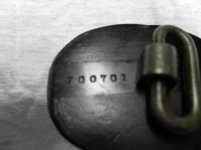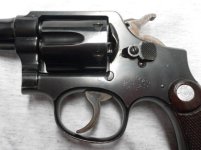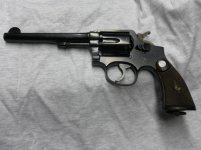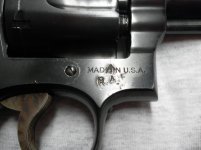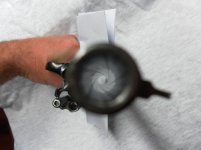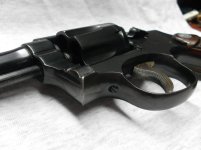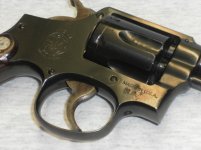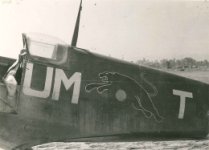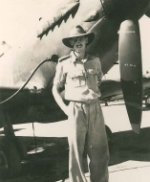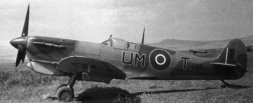I have been very lucky in purchasing a revolver issued to an RAF fighter pilot from WW2 and its what I would describe (without the exact model Mk knowledge !) as a pre Victory model M&P serial no. 700701. The RAF stamp is stamped over the Made in USA marks on the left side of the frame.
I know it was shot down twice whilst in a holster worn by the pilot once in North Africa and once in Burma but after close strip down and examination today I am amazed at what an excellent condition it is in. It was carried daily by all accounts in a holster in extreme weather conditions especially in the jungle but its bluing is perfect at about 70% with three rust corrosion spots. On the frame (where the RAF initials are stamped), one on one of the cylinder recesses and a spot on the barrel. There is minor holster wear at the end of the barrel but apart from that it all seems pretty perfect elsewhere.
I have a few revolvers that have been refinished (pre WWI and issue WWI Webleys) and they clearly have been re finished to the untrained eye, but this gun just looks original despite what hardships it must have faced. Is there any way I can tell for sure if it was refinished ?
There is no british military stampings on it at all surprisingly (apart from the RAF marks) - trust me I know how my country used to love stamping marks everywhere on guns but this has none !! I have the Webleys with unit marks and proof stamps everywhere and a S&W .455 MKII which has the expected proof, military broard arrow and decommission marks but the .38 has none of these apart from a Brit nitro proof mark.
The case hardening is crisp and there is no wearing off of the S&W logo on the right plate as you might expect with polishing. In fact the very fact the RAF stamp is rusted in the grooves of the stamp makes me think its original finish. Someone at one stage did use the left side of the frame to either hammer a nail or something similar (I like to imagine the pilot hitting a vital Spitfire instrument panel gauge in flight trying to make it work !) but I am sure it was something as simple as it being used as a tool with no hammer to hand !!
Also someone somewhere prior to it being issued to the pilot did a trigger job on it - the single action pull is a beautiful crisp 2lbs. The pilot is still alive and I have been in contact with him and one of his main recollections was when he remarked about how light the trigger pull was on the gun. I cant imagine this was a RAF armorer doing this - could this have been a factory trigger pull at that time for a war issue gun ??
I have to take and post some photos tomorrow as this gun fascinates me and now our gun laws ban us from owning such guns I know how lucky I am in having this !
I know it was shot down twice whilst in a holster worn by the pilot once in North Africa and once in Burma but after close strip down and examination today I am amazed at what an excellent condition it is in. It was carried daily by all accounts in a holster in extreme weather conditions especially in the jungle but its bluing is perfect at about 70% with three rust corrosion spots. On the frame (where the RAF initials are stamped), one on one of the cylinder recesses and a spot on the barrel. There is minor holster wear at the end of the barrel but apart from that it all seems pretty perfect elsewhere.
I have a few revolvers that have been refinished (pre WWI and issue WWI Webleys) and they clearly have been re finished to the untrained eye, but this gun just looks original despite what hardships it must have faced. Is there any way I can tell for sure if it was refinished ?
There is no british military stampings on it at all surprisingly (apart from the RAF marks) - trust me I know how my country used to love stamping marks everywhere on guns but this has none !! I have the Webleys with unit marks and proof stamps everywhere and a S&W .455 MKII which has the expected proof, military broard arrow and decommission marks but the .38 has none of these apart from a Brit nitro proof mark.
The case hardening is crisp and there is no wearing off of the S&W logo on the right plate as you might expect with polishing. In fact the very fact the RAF stamp is rusted in the grooves of the stamp makes me think its original finish. Someone at one stage did use the left side of the frame to either hammer a nail or something similar (I like to imagine the pilot hitting a vital Spitfire instrument panel gauge in flight trying to make it work !) but I am sure it was something as simple as it being used as a tool with no hammer to hand !!
Also someone somewhere prior to it being issued to the pilot did a trigger job on it - the single action pull is a beautiful crisp 2lbs. The pilot is still alive and I have been in contact with him and one of his main recollections was when he remarked about how light the trigger pull was on the gun. I cant imagine this was a RAF armorer doing this - could this have been a factory trigger pull at that time for a war issue gun ??
I have to take and post some photos tomorrow as this gun fascinates me and now our gun laws ban us from owning such guns I know how lucky I am in having this !

